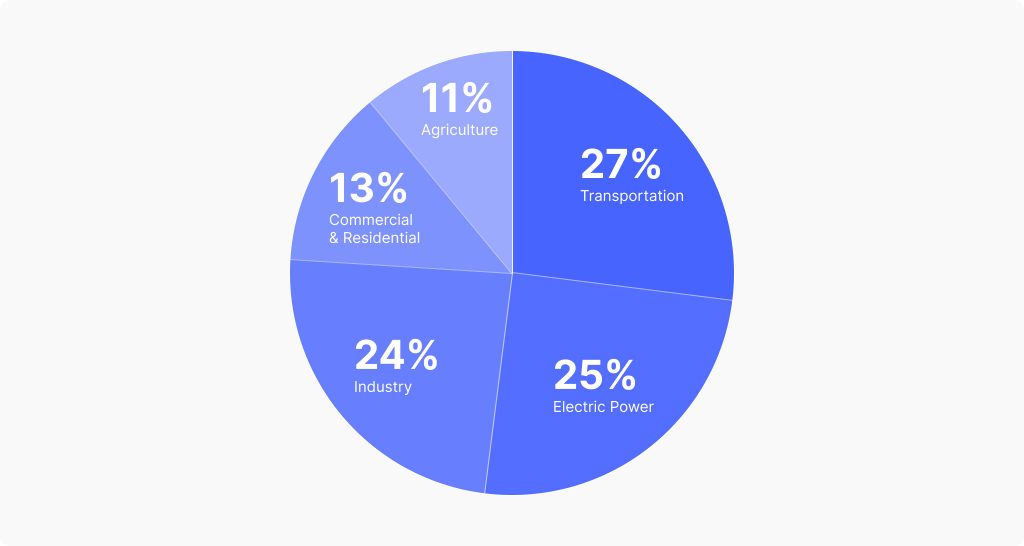Climate Change & AI: How Artificial Intelligence Is Solving Climate Issues

Climate change may not always be at the tip of our tongues, but it is likely on our minds. And it should be. Climate change is set to have a significant impact not only on the planet but on our wider ecosystem, including social, environmental, and economic aspects. Preventing future damage to the climate or, at the very least, reducing the impact of climate change is vital. Now, scientists suggest that climate change AI technology could help. Let’s see why.
Why Does Climate Change Matter? Climate Change Analytics

Over the last few years, the world has been focused on almost anything except climate change. First, there was the pandemic, then just as the world started to enjoy the signs of recovery, an economic crisis hit. As we continue to experience the effects of inflation and the rise in living costs, it may seem that climate change may not be all that important right now. Except it is. The drive toward zero greenhouse gas emissions by 2050 — just 30 years from now — wasn’t designed from thin air. Instead, it looks at how governments, individuals, investors, and corporations can work together to ensure a better environmental future.
But just why is tackling climate change so important right now? What do climate data analytics say?
According to NASA, these are the latest climate data analytics and statistics we should be aware of telling us of a declining environmental picture:
- The global 1ºC since 1880. Although this doesn’t sound like much, it’s important to remember that 19 of the hottest days ever have occurred in the last 22 years.
- The sea level has risen 4 inches since 1993. This is primarily the result of ice caps melting.
- 419 parts per million are the amount of Carbon Dioxide in the atmosphere. CO2 is a heat-trapping gas that stores heat. It’s also better known as green-house gas.
- Ice sheets are melting at a rate of 427 billion metric tons per year.
Top Sources of Greenhouse Gas Emissions

Add that to a population increase of a predicted 9.7 billion by 2050, and it’s clear that climate change shouldn’t be a back-of-the-mind issue. It should take center stage.
AI for Climate Change: Top 5 Solutions Today
Knowing the climate change data analysis stats, it’s difficult not to be motivated to take action. Everyone has their reasons for doing so: from wanting to preserve the plant to love for a particular nearly-extinct animal species or even a return on green investments. The only question is how?
The latest news suggests that tackling climate change with machine learning (ML) and AI technology could prove effective. Here are some of the solutions currently being used to transform global warming data analysis statistics from a negative downturn to a positive movement.
5 ways climate change AI could change the game
#1. Tracking deforestation with smart AI
New technologies are being developed all the time, and they can have immense outcomes. No more so that preventing deforestation — is a key to lowering greenhouse gas emissions. Such climate change AI technology has already been rolled out to track deforestation in the formidable Amazon, but its usage could and should expand to any woodland area.
#2. Building smarter cities
Plans have already been set in motion in China to develop the world’s first “smart city”. But what is a smart city? It is one that utilizes technology to improve not only the lives of people but the environment they inhabit. Equipped with fewer private vehicles, more public transport, garden roofs, and smart city engineering, such a concept could lower the world’s carbon footprint significantly.
#3. Smart home tools for energy monitoring
We could all stand to be a bit more energy efficient. Perhaps that means a one-cup kettle, using fewer fossil fuels, installing solar panels, or switching to smart home systems. By onboarding in-home AI climate change technology, it’s possible to reduce and monitor an individual home’s carbon footprint. Multiply that on a larger scale, and the results can be impressive.
#4. Monitoring needs, supply chains, and usage
With world inequality remaining an issue — the poorest 50% hold 8.5% of the world’s wealth, while the top 10% hold 50% of it — it’s clear our problem doesn’t amount. It’s distribution. By monitoring needs, supply chains, and usage, it’s possible using AI technology to reduce waste and improve access. AI for climate change could help reverse the trends in global inequality and drive a more accessible, sustainable future.
#5. Constructing predictive AI models
To know where we are headed, it’s vital to know the data. That’s where AI for climate change comes in. Tools, such as GiniMachine, can help create and construct predictive models of future behavior based on past data. This can then be utilized by stakeholders to construct strategies for climate change reduction. For example, an environmental data analyst could utilize these insights to inform on policy change and create a wider-scale impact.
Are There Any Limitations of Climate Change AI?
Of course, no technology is perfect, no matter how smart it is. Although AI for climate change is a formidable solution to a pressing problem, it is not an all-encompassing one.
- Human action is required. For climate change to be slowed, no amount of AI can do such a task on its own. Instead, it will require the physical effort of humans to engage with and act upon the data they are receiving.
- No statistical data is perfect. Although AI gets pretty close to perfection when its data is trained and tested correctly, it’s important to remember that this data entry is a significant step. Failure to engage in the full AI solution cycle could doom it to failure.
- It needs to be part of a wider strategy. Just as climate change requires human action and correct data, so too does it be part of a wider solution. A strategy built solely around AI doesn’t always take into account other factors that could be equally as influential.
- AI technology can be energy-inefficient. With AI trending, not just in the climate change sector, governments are expressing concern that it could be energy inefficient in and of itself. This is why more advanced low-energy AI solutions could be set to be a priority for scientists in the coming years.
Is AI for Climate Change the Solution?
AI for climate change is a powerful tool in any eco-warrior’s toolkit — whether that ‘warrior’ be a government official, individual, executive, or investor. With initial use cases providing promising results, it’s clear that AI is a tool for the future. That said, it is still in its infancy in terms of usage, and as the tech progresses, we are likely to observe more promising results from this smart solution.
Interested in building predictive models? GiniMachine can help. Sign in and start a free trial to see AI in action.



